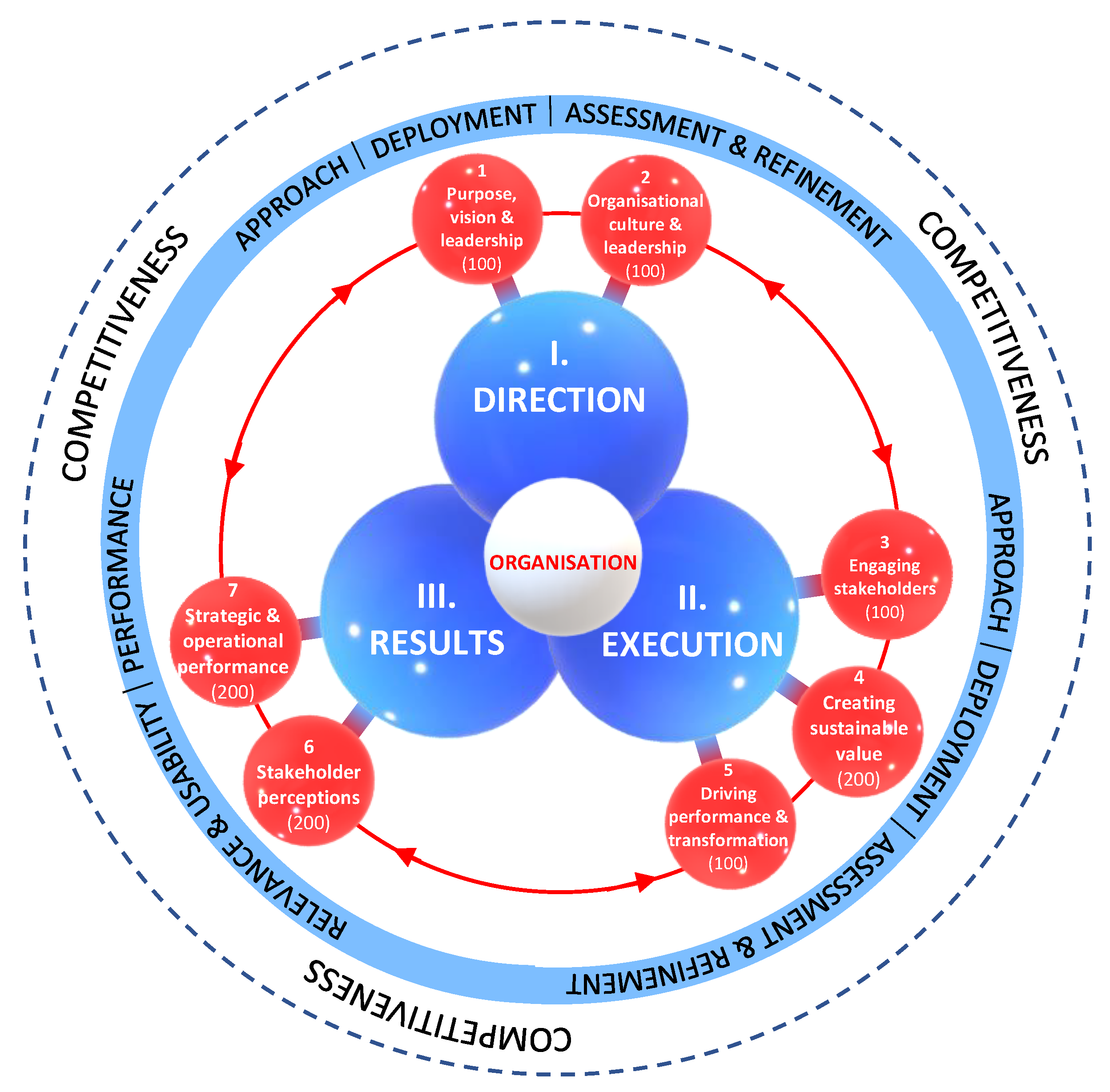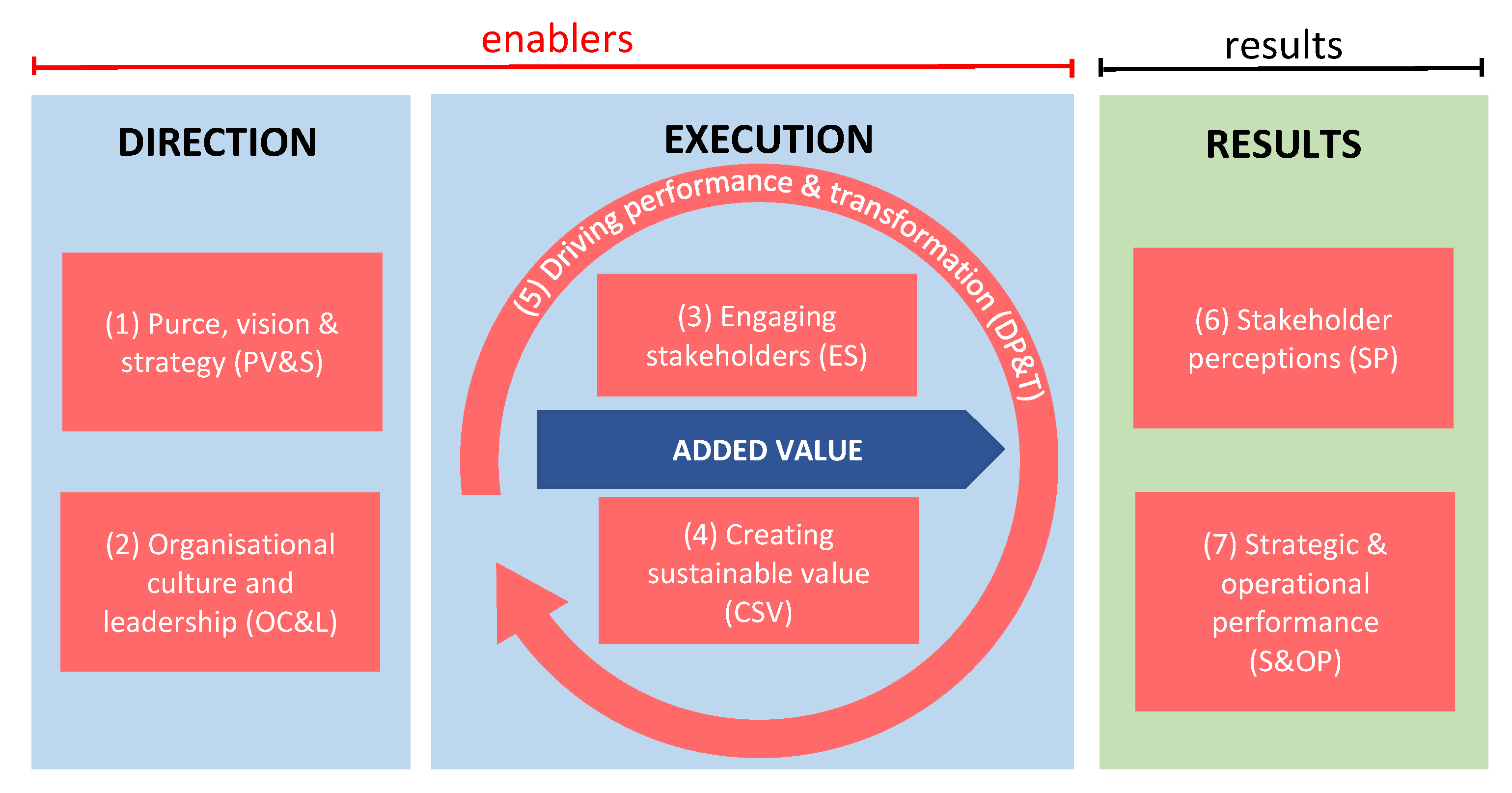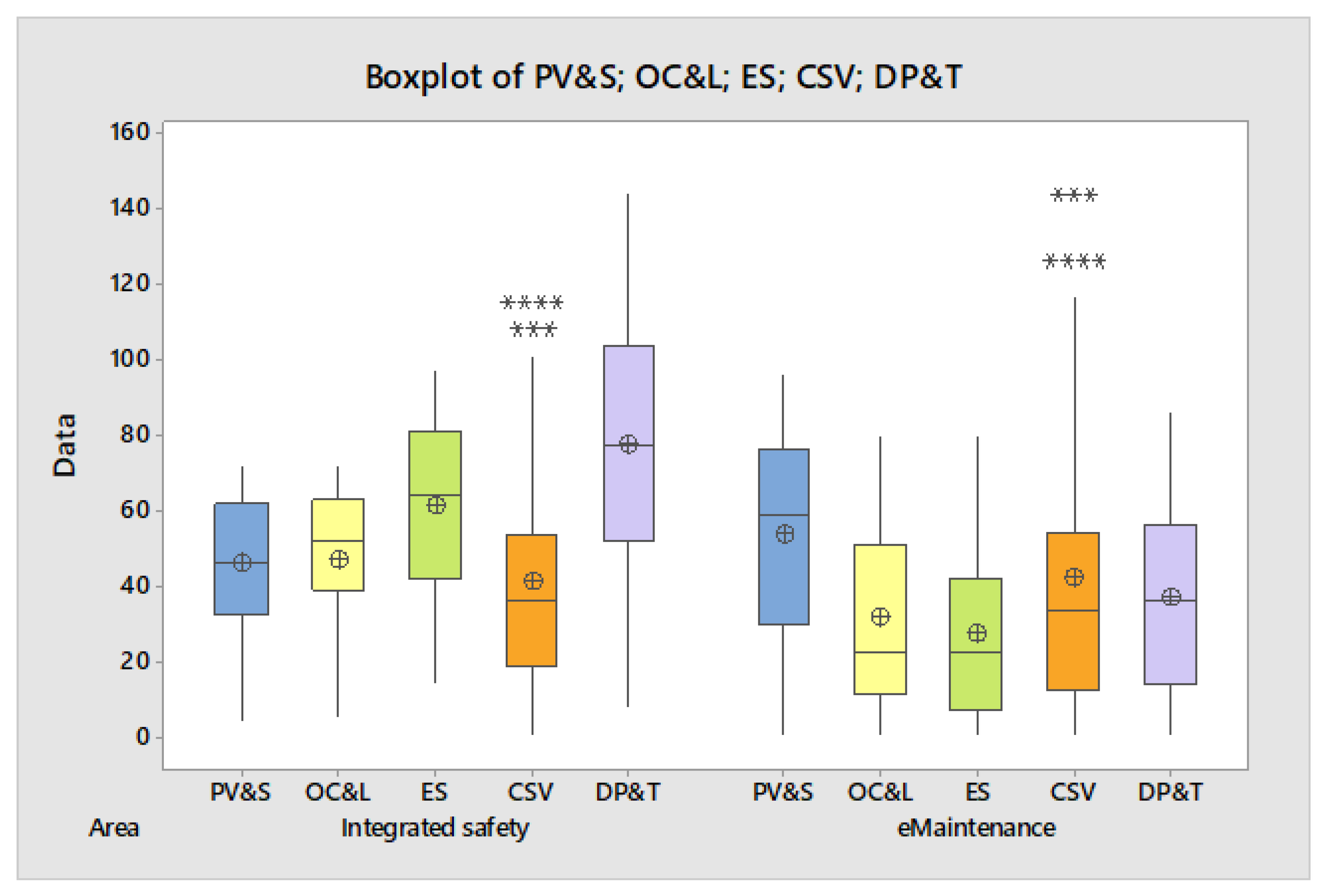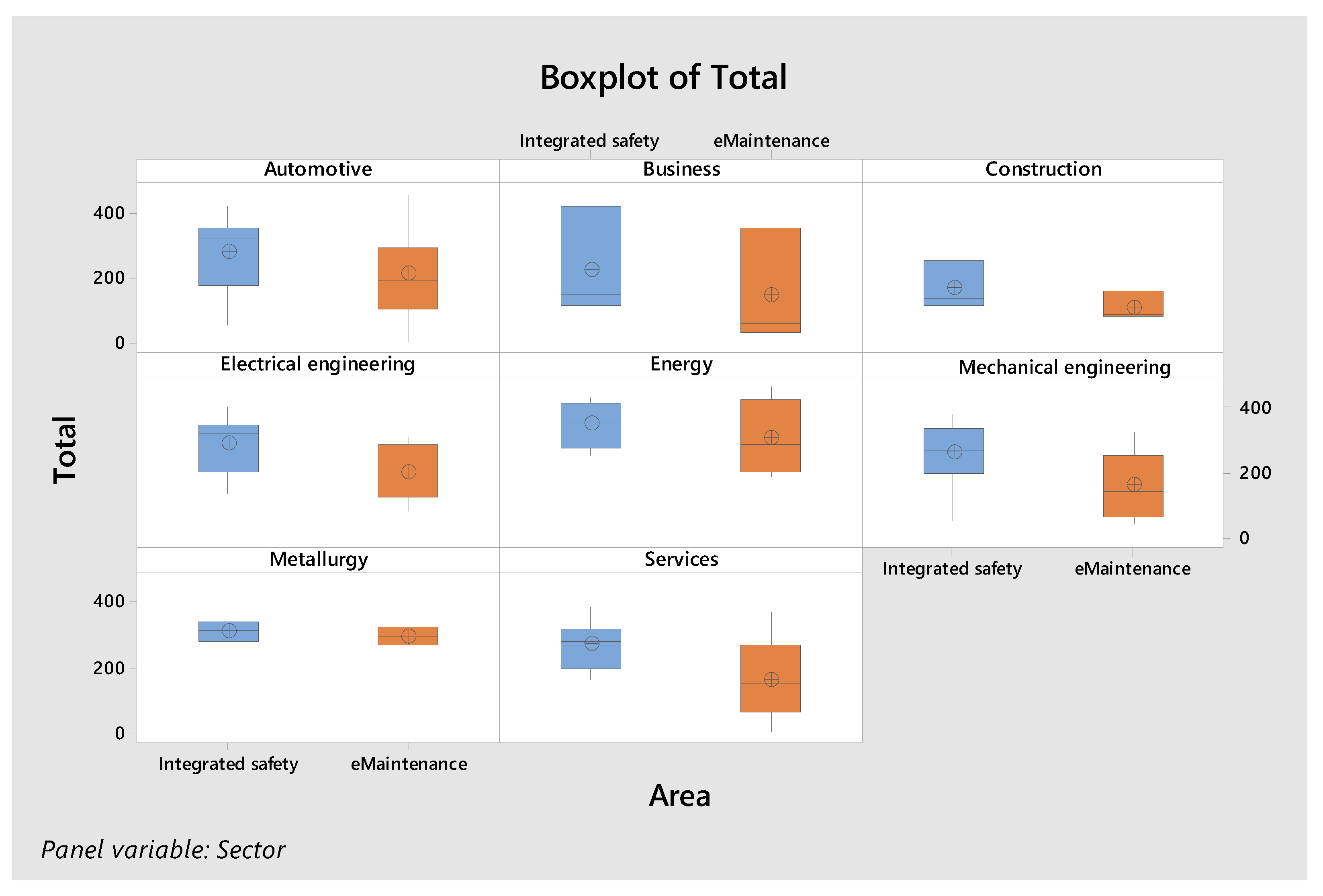Evaluation of eMaintenance Application Based on the New Version of the EFQM Model
Abstract
1. Introduction
2. Literature Review
3. Materials and Methods
3.1. Exceptionality Criteria
3.2. Organization Readiness Model
4. Results
5. Discussion
6. Conclusions
Author Contributions
Funding
Institutional Review Board Statement
Informed Consent Statement
Data Availability Statement
Acknowledgments
Conflicts of Interest
Appendix A
| Criterion | Question | Analysis of Integration Safety (IS) and Maintenance (eM) |
|---|---|---|
| PV&S | 1 | In your organization, is there a clearly defined purpose/target for IS/eM areas (e.g., vision of safety, asset management, its maintenance and I4.0)? |
| PV&S | 2 | Does your organization look into the needs of involved parties for IS/eM areas (e.g., requirements of legislation, customers and employees in safety area, safety devices that must be implemented on ‘your’ machines and their maintenance)? |
| PV&S | 3 | Does the organization collect information and seek opportunities or challenges for IS/eM areas (e.g., requirements for a Logout/Tagout system (LOTO) and supplied machines, additional safety devices, or news, so that high safety culture in the organization is reached)? |
| PV&S | 4 | Is the strategy of your organization focused on seeking adequate answers to challenges for IS/eM areas? (e.g., is there a preference for predictive maintenance and its diagnostics for critical machines? Is there a high integrated safety level required, e.g., are the best solutions searched for?) |
| PV&S | 5 | Have you implemented a system of reporting in order to correctly check the services and find process effectivity for IS/eM areas? (have you implemented key performance indicators (KPIs) for safety and maintenance? Are they measurable? Is their regular evaluation clearly defined in the system? Is customer satisfaction evaluated: customers and also maintenance, e.g., operational manager and occupational health and safety (OHS) manager) |
| OC&L | 6 | Does your organization define its values and derive specific steps from them for IS/eM areas? (are (key performance indicators (KPIs) in maintenance in accordance with the goals of both the organization and OHS? Is there anyone responsible and does their regular evaluation have an effect on the improvement) |
| OC&L | 7 | Is interaction with involved parties at IS/eM area development supported? (are concerned employees addressed, e.g., when choosing protective devices and LOTO devices?) |
| OC&L | 8 | Do you feel support from the part of your organization for employees who want to make changes up to the level of radical transformation in IS/eM area? |
| OC&L | 9 | Does the organization collect feedback from involved parties about activities in IS/eM areas (e.g., the opinion of the operator, maintenance manager, operational manager, customer, OHS manager, etc.)? |
| ES | 10 | Does the organization use communication channels enabling customers to communicate with the organization easily and continuously in IS/eM areas? (Are they also online, …, top level?) |
| ES | 11 | Does the organization enable its employees to actively participate in the value creation process in IS/eM areas? (mainly with regard to I4.0 trends, does it support LOTO training, diagnostic methods, new safety software and devices?) |
| ES | 12 | Do business or regulation oriented involved parties join in with the strategy creation within IS/eM areas (customers and their satisfaction, inspectors, etc.)? |
| ES | 13 | Does the organization actively use all opportunities for its development in IS/eM areas (trainings, seminars, ministry calls for projects, customers, and their requirements, etc.)? |
| ES | 14 | Does the organization join its partners and suppliers in their business activities in such a way that it creates a high degree of transparency and trust, as for the aims related to IS and eM areas (e.g.,: requirements for spare parts suppliers, for safety devices, LOTO solutions, safe behavior, etc.)? |
| CSV | 15 | Does the organization develop its product portfolio in order to meet current and future expectations of customer groups in IS and eM areas? |
| CSV | 16 | Does an external company provide you with activities in the organization for IS/eM areas? |
| CSV | 17 | Does the organization minimize the negative ecological and social effects of its own activities for IS and eM areas? |
| CSV | 18 | Is your organization oriented on building customer experience in IS and eM area (e.g., the feedback work, failures, accidents, etc.)? |
| DP&T | 19 | Does your organization identify, analyze, and subsequently manage risks or take account of perspectives in IS/eM areas (risk assessment and management, e.g.,: criticality of machinery, FMEA, (Failure mode and effects analysis) etc., risk assessment during changes on a machine, hazardous energy identification, etc.)? |
| DP&T | 20 | Is the organizational structure of your organization compatible with the current strategy? Is it regularly updated for IS/eM areas? |
| DP&T | 21 | Does the organization introduce new effective technologies for IS/eM areas? (Who is responsible for new trends?) |
| DP&T | 22 | Does the organization use its own knowledge and access knowledge for third parties to cooperate with other involved parties to improve value creation in IS/eM areas (e.g., with research institutions)? |
| DP&T | 23 | Does the organization sufficiently use its financial sources for IS/eM areas? |
References
- Ejsmont, K. The Impact of Industry 4.0 on Employees—Insights from Australia. Sustainability 2021, 13, 3095. [Google Scholar] [CrossRef]
- Miśkiewicz, R.; Wolniak, R. Practical Application of the Industry 4.0 Concept in a Steel Company. Sustainability 2020, 12, 5776. [Google Scholar] [CrossRef]
- Castelo-Branco, I.; Cruz-Jesus, F.; Oliveira, T. Assessing Industry 4.0 readiness in manufacturing: Evidence for the European Union. Comput. Ind. 2019, 107, 22–32. [Google Scholar] [CrossRef]
- Rekordné Číslo. Slovensko Ostáva Lídrom vo Výrobe Áut na Obyvateľa. Available online: https://ekonomika.sme.sk/c/22299052/slovensko-ostava-lidrom-v-produkcii-automobilov-na-obyvatela.html (accessed on 20 January 2021).
- Koncepcia Inteligentného Priemyslu pre Slovensko. Available online: https://www.mhsr.sk/inovacie/strategie-a-politiky/smart-industry (accessed on 15 March 2021).
- Grenčíková, A.; Kordoš, M.; Sokol, J. The Approach to Industry 4.0 within the Slovak Business Environment. Soc. Sci. 2019, 8, 104. [Google Scholar] [CrossRef]
- Turisová, R.; Sinay, J.; Pačaiová, H.; Kotianová, Z.; Glatz, J. Application of the EFQM Model to Assess the Readiness and Sustainability of the Implementation of I4.0 in Slovakian Companies. Sustainability 2020, 12, 5591. [Google Scholar] [CrossRef]
- Radanliev, P.; De Roure, D.; Van Kleek, M.; Santos, O.; Ani, U. Artificial intelligence in cyber physical systems. AI Soc. 2020. [Google Scholar] [CrossRef] [PubMed]
- Piccarozzi, M.; Aquilani, B.; Gatti, C. Industry 4.0 in Management Studies: A Systematic Literature Review. Sustainability 2018, 10, 3821. [Google Scholar] [CrossRef]
- Madsen, D.Ø. The Emergence and Rise of Industry 4.0 Viewed through the Lens of Management Fashion Theory. Adm. Sci. 2019, 9, 71. [Google Scholar] [CrossRef]
- Zheng, T.; Ardolino, M.; Bacchetti, A.; Perona, M. The applications of Industry 4.0 technologies in manufacturing context: A systematic literature review. Int. J. Prod. Res. 2020, 1–20. [Google Scholar] [CrossRef]
- Felsberger, A.; Reiner, G. Sustainable Industry 4.0 in Production and Operations Management: A Systematic Literature Review. Sustainability 2020, 12, 7982. [Google Scholar] [CrossRef]
- Sartal, A.; Bellas, R.; Mejías, A.M.; García-Collado, A. The sustainable manufacturing concept, evolution and opportunities within Industry 4.0: A literature review. Adv. Mech. Eng. 2020, 12, 1–17. [Google Scholar] [CrossRef]
- Galvez, N.; Marsot, J.; Martin, P.; Siadat, A.; Etienne, A. EZID: A new approach to hazard identification during the design process by analysing energy transfers. Saf. Sci. 2017, 95, 1–14. [Google Scholar] [CrossRef]
- Etherton, J.R.; Myers, M.L. Machine safety research at NIOSH and the future directions. Int. J. Ind. Ergon. 1990, 6, 163–174. [Google Scholar] [CrossRef]
- Gardner, D.; Carlopio, J.; Fonteyn, P.N.; Cross, J.A. Mechanical Equipment Injuries in Small Manufacturing Businesses. Knowledge, Behavioral, and Management Issues. Int. J. Occup. Saf. Ergon. 1999, 5, 59–71. [Google Scholar] [CrossRef] [PubMed]
- European Parliament and of the Council. Directive 2006/42/EC of the European Parliament and of the Council of 17 May 2006 on Machinery, and Amending Directive 95/16/EC (Recast); European Parliament and of the Council: Brussels, Belgium, 2006. [Google Scholar]
- European Parliament and of the Council. Directive 2009/104/EC of the European Parliament and of the Council of 16 September 2009 Concerning the Minimum Safety and Health Requirements for the Use of Work Equipment by Workers at Work (Second Individual Directive Within the Meaning of Article 16(1) of Directive 89/391/EEC); European Parliament and of the Council: Brussels, Belgium, 2009. [Google Scholar]
- Calabrese, F.; Regattieri, A.; Botti, L.; Mora, C.; Galizia, F.G. Unsupervised Fault Detection and Prediction of Remaining Useful Life for Online Prognostic Health Management of Mechanical Systems. Appl. Sci. 2020, 10, 4120. [Google Scholar] [CrossRef]
- Mwanza, B.G.; Mbohwa, C. Safety in Maintenance: An Improvement Framework. Procedia Manuf. 2017, 8, 657–664. [Google Scholar] [CrossRef]
- Aust, J.; Pons, D. Bowtie Methodology for Risk Analysis of Visual Borescope Inspection during Aircraft Engine Maintenance. Aerospace 2019, 6, 110. [Google Scholar] [CrossRef]
- Gligorijevic, J.; Gajic, D.; Brkovic, A.; Savic-Gajic, I.; Georgieva, O.; Di Gennaro, S. Online Condition Monitoring of Bearings to Support Total Productive Maintenance in the Packaging Materials Industry. Sensors 2016, 16, 316. [Google Scholar] [CrossRef]
- Xiang, Z.T.; Feng, C.J. Implementing total productive maintenance in a manufacturing small or medium-sized enterprise. J. Ind. Eng. Manag. 2021, 14, 1–24. [Google Scholar] [CrossRef]
- Igba, J.; Alemzadeh, K.; Anyanwu-Ebo, I.; Gibbons, P.; Friis, J. A Systems Approach Towards Reliability-Centred Maintenance (RCM) of Wind Turbines. Procedia Comput. Sci. 2013, 16, 814–823. [Google Scholar] [CrossRef]
- Carretero, J.; Pérez, M.J.; García-Carballeira, F.; Calderón, A.; Fernández, J.; García, J.D.; Lozano, A.; Cardona, L.; Cotaina, N.; Prete, P. Applying RCM in large scale systems: A case study with railway networks. Reliab. Eng. Syst. Saf. 2003, 82, 257–273. [Google Scholar] [CrossRef]
- Ambühl, S.; Dalsgaard Sørensen, J. Sensitivity of Risk-Based Maintenance Planning of Offshore Wind Turbine Farms. Energies 2017, 10, 505. [Google Scholar] [CrossRef]
- Tan, Z.; Li, J.; Wu, Z.; Zheng, J.; He, W. An evaluation of maintenance strategy using risk based inspection. Saf. Sci. 2011, 49, 852–860. [Google Scholar] [CrossRef]
- Ugechi, C.I.; Ogbonnaya, E.A.; Lilly, M.T.; Ogaji, S.O.T.; Probert, S.D. Condition-Based Diagnostic Approach for Predicting the Maintenance Requirements of Machinery. Engineering 2009, 1, 177–187. [Google Scholar] [CrossRef][Green Version]
- Štancel, M.; Pačaiová, H.; Chovancová, E. Maintenance performance audit software. In Proceedings of the 2017 IEEE 15th International Symposium on Applied Machine Intelligence and Informatics (SAMI), Herl’any, Slovakia, 26–28 January 2017; pp. 455–460. [Google Scholar] [CrossRef]
- Carnero, M.C. Selection of diagnostic techniques and instrumentation in a predictive maintenance program. A case study. Decis. Support Syst. 2005, 38, 539–555. [Google Scholar] [CrossRef]
- Neslušan, M.; Minárik, P.; Grenčík, J.; Trojan, K.; Zgútová, K. Non-destructive evaluation of the railway wheel surface damage after long-term operation via Barkhausen noise technique. Wear 2019, 420–421, 195–206. [Google Scholar] [CrossRef]
- Stejskal, T.; Dovica, M.; Svetlik, J.; Demec, P. Experimental assessment of the static stiffness of machine parts and structures by changing the magnitude of the hysteresis as a function of loading. Open Eng. 2019, 9, 655–659. [Google Scholar] [CrossRef]
- Hovanec, M. Digital factory as a prerequisite for successful application in the area of ergonomics and human factor. Theor. Issues Ergon. Sci. 2017, 18, 35–45. [Google Scholar] [CrossRef]
- Vaidya, S.; Ambad, P.; Bhosle, S. Industry 4.0—A Glimpse. Procedia Manuf. 2018, 20, 233–238. [Google Scholar] [CrossRef]
- Alcácer, V.; Cruz-Machado, V. Scanning the Industry 4.0: A Literature Review on Technologies for Manufacturing Systems. Eng. Sci. Technol. Int. J. 2019, 22, 899–919. [Google Scholar] [CrossRef]
- Hovanec, M.; Pačaiová, H.; Hrozek, F.; Varga, M. Proactive Ergonomics Based on Digitalization Using 3D Scanning and Workplace Modeling in Texnomatix Jack with Augmented Reality. Naše More 2014, 61, 22–26. [Google Scholar]
- Culot, G.; Nassimbeni, G.; Orzes, G.; Sartor, M. Behind the definition of Industry 4.0: Analysis and open questions. Int. J. Prod. Econ. 2020, 226, 1–15. [Google Scholar] [CrossRef]
- Talapatra, S.; Santos, G.; Uddin, K.; Carvalho, F. Main benefits of integrated management systems through literature review. Int. J. Qual. Res. 2019, 13, 1037–1054. [Google Scholar] [CrossRef]
- Bennett, N.; Lemoine, G.J. What a difference a word makes: Understanding threats to performance in a VUCA world. Bus. Horiz. 2014, 57, 311–317. [Google Scholar] [CrossRef]
- Pačaiová, H.; Nagyová, A. Risk Based Thinking—New Approach for Modern Enterprises’ Management. In Proceedings of the Advances in Human Factors, Business Management and Society, Orlando, FL, USA, 21–25 July 2018; Springer: Cham, Switzerland, 2018; pp. 524–536. [Google Scholar] [CrossRef]
- Chiarini, A. Risk-based thinking according to ISO 9001:2015 standard and the risk sources European manufacturing SMEs intend to manage. TQM J. 2017, 29, 310–323. [Google Scholar] [CrossRef]
- Pexa, M.; Hladík, T.; Ales, Z.; Legát, V.; Müller, M.; Valášek, P.; Havl, V. Reliability and risk treatment centered maintenance. J. Mech. Sci. Technol. 2014, 28, 3963–3970. [Google Scholar] [CrossRef]
- Johansson, N.; Roth, E.; Reim, W. Smart and Sustainable eMaintenance: Capabilities for Digitalization of Maintenance. Sustainability 2019, 11, 3553. [Google Scholar] [CrossRef]
- Iunga, B.; Levrata, E.; Marquezb, A.C.; Erbec, H. Conceptual framework for e-Maintenance: Illustration by e-Maintenance technologies and platforms. Annu. Rev. Control. 2009, 33, 220–229. [Google Scholar] [CrossRef]
- Jasiulewicz-Kaczmarek, M.; Gola, A. Maintenance 4.0 Technologies for Sustainable Manufacturing—an Overview. IFAC PapersOnLine 2019, 52, 91–96. [Google Scholar] [CrossRef]
- Cachada, A.; Barbosa, J.; Leitño, P.; Gcraldcs, G.; Deusdado, L.; Costa, J.; Teixeira, C.; Teixeira, J.; Moreira, A.H.J.; Moreira, P.M.; et al. Maintenance 4.0: Intelligent and Predictive Maintenance System Architecture. In Proceedings of the 2018 IEEE 23rd International Conference on Emerging Technologies and Factory Automation (ETFA), Turin, Italy, 4–7 September 2018. [Google Scholar] [CrossRef]
- Bokrantz, J.; Skoogh, A.; Berlin, C.; Wuest, T.; Stahre, J. Smart Maintenance: A research agenda for industrial maintenance management. Int. J. Prod. Econ. 2020, 224, 1–14. [Google Scholar] [CrossRef]
- Bumblauskas, D.; Gemmill, D.; Igou, A.; Anzengruber, J. Smart Maintenance Decision Support Systems (SMDSS) based on corporate big data analytics. Expert Syst. Appl. 2017, 90, 303–317. [Google Scholar] [CrossRef]
- Pačaiová, H.; Glatz, J.; Kacvinský, Š. Positive and negative aspect in application of maintenance management philosophy. J. Appl. Eng. Sci. 2012, 10, 99–105. [Google Scholar] [CrossRef]
- Kužma, D.; Korba, P.; Hovanec, M.; Dulina, L. The Use of CAX Systems as a Tool for Modeling Construction Element in the Aviation Industry. Naše More 2016, 63, 134–139. [Google Scholar] [CrossRef]
- Racz, S.G.; Breaz, R.E.; Cioca, L.I. Evaluating Safety Systems for Machine Tools with Computer Numerical Control using Analytic Hierarchy Process. Safety 2019, 5, 14. [Google Scholar] [CrossRef]
- Pacana, A.; Siwiec, D.; Bednárová, L. Method of Choice: A Fluorescent Penetrant Taking into Account Sustainability Criteria. Sustainability 2020, 12, 5854. [Google Scholar] [CrossRef]
- EFQM Model. The EFQM Excellence Model; EFQM: Brussels, Belgium, 2020; Available online: http://www.efqm.org (accessed on 25 February 2021).
- Nenadál, J. The new EFQM model: What is really new and could be considered as a suitable tool with respect to quality 4.0 concept? Qual. Innov. Prosper. 2020, 24, 17–28. [Google Scholar] [CrossRef]
- Suárez, E.; Calvo-Mora, A.; Roldan, J.R.; Perianez-Cristobal, R. Quantitative research on the EFQM excellence model: A systematic literature review (1991–2015). Eur. Res. Manag. Bus. Econ. 2017, 23, 147–156. [Google Scholar] [CrossRef]
- Wang, G.; Liu, H.; Li, H.; Luo, X.; Liu, J. A Building Project-Based Industrialized Construction Maturity Model Involving Organizational Enablers: A Multi-Case Study in China. Sustainability 2020, 12, 4029. [Google Scholar] [CrossRef]
- Leonard, D. Leveraging the Benefits of the EFQM Innovation Lens and ISO 56002 Innovation Management Systems Guidance. Qual. Manag. Forum 2020, 46, 1–7. [Google Scholar]
- Fonseca, L.; Amaral, A.; Oliveira, J. Quality 4.0: The EFQM 2020 Model and Industry 4.0 Relationships and Implications. Sustainability 2021, 13, 3107. [Google Scholar] [CrossRef]
- Ghasemi, A.; Nadiri, M. Performance assessment of Iranian petrochemical companies using sustainable excellence model. Saf. Sci. 2016, 87, 280–291. [Google Scholar] [CrossRef]
- Cavalcante, C.A.V.; Lopes, R.S. Multi-criteria model to support the definition of opportunistic maintenance policy: A study in a cogeneration system. Energy 2015, 80, 32–40. [Google Scholar] [CrossRef]
- Ghobakhloo, M. Industry 4.0, digitization, and opportunities for sustainability. J. Clean. Prod. 2020, 252, 1–21. [Google Scholar] [CrossRef]
- Maletič, D.; Maletič, M.; Al-Najjar, B.; Gomišček, B. An Analysis of Physical Asset Management Core Practices and Their Influence on Operational Performance. Sustainability 2020, 12, 9097. [Google Scholar] [CrossRef]
- Opocenska, H.; Nahodil, P.; Hammer, M. Use of multiparametric diagnostics in predictive maintenance. MM Sci. 2017, 2017, 2090–2093. [Google Scholar] [CrossRef]
- Baron, P.; Kočiško, M.; Dobránsky, J.; Pollák, M.; Telišková, M. Research and application of methods of technical diagnostics for the verification of the design node. Measurement 2016, 94, 245–253. [Google Scholar] [CrossRef]
- Tureková, I.; Depešová, J.; Bagalová, T. Machinery Risk Analysis Application in the System of Employee Training. Appl. Mech. Mater. 2014, 635–637, 439–442. [Google Scholar] [CrossRef]
- Zgodavova, K.; Kisela, M.; Sutoova, A. Intelligent approaches for an organisation’s management system change. TQM J. 2016, 28, 760–773. [Google Scholar] [CrossRef]
- Pačaiová, H.; Andrejiová, M.; Balažiková, M.; Tomašková, M.; Gazda, T.; Chomová, K.; Hijj, J.; Salaj, L. Methodology for Complex Efficiency Evaluation of Machinery Safety Measures in a Production Organization. Appl. Sci. 2021, 11, 453. [Google Scholar] [CrossRef]
- Tubis, A.A.; Werbińska-Wojciechowska, S.; Góralczyk, M.; Wróblewski, A.; Ziętek, B. Cyber-Attacks Risk Analysis Method for Different Levels of Automation of Mining Processes in Mines Based on Fuzzy Theory Use. Sensors 2020, 20, 7210. [Google Scholar] [CrossRef]






| Assumption Criteria | Description |
|---|---|
| Purpose, vision, and strategy (PV&S) | An excellent organization is defined by inspiring purpose and vision, developing an effective strategy aimed at the creation of sustainable advantages and creation, and implementation of an organization management system and efficiency management system. |
| Organizational culture and leadership (OC&L) | Organizational culture is conditioned by values and standards of organization behavior that are shared by its employees in the organization and which form their behavior, as well as their behavior towards involved parties that are important from the view of purpose, vision, and strategy. |
| Engaging stakeholders (ES) | An excellent organization identifies individual types and categories within involved parties (customers, employees, company, partners, suppliers) that are important for purpose, vision, and strategy. It creates a sustainable value, evaluates its own performance, and takes appropriate measures to ensure its own future. |
| Creating sustainable value (CSV) | An excellent organization understands that creating sustainable values is crucial for long-term development and financial force. A clearly defined purpose, together with a strategy, determine for whom the organization creates sustainable advantages. |
| Driving performance and transformation (DP&T) | In order for an organization to be excellent today and in the future, it must be able to successfully manage and improve everyday business and manage changes that constantly happen inside and outside the organization. |
| Criterion. | IS | eM | Total | ||||
|---|---|---|---|---|---|---|---|
| Number of Questions | Max. Points | Total Points | Number of Questions | Max. Points | Total Points | ||
| PV&S | 5 | 16 | 80 | 5 | 16 | 80 | 160 |
| OC&L | 4 | 20 | 80 | 4 | 20 | 80 | 160 |
| ES | 5 | 16 | 80 | 5 | 16 | 80 | 160 |
| CSV | 4 | 45 | 180 | 4 | 45 | 180 | 360 |
| DP&T | 5 | 16 | 80 | 5 | 16 | 80 | 160 |
| Total | 23 | - | 500 | 23 | - | 500 | 1000 |
Publisher’s Note: MDPI stays neutral with regard to jurisdictional claims in published maps and institutional affiliations. |
© 2021 by the authors. Licensee MDPI, Basel, Switzerland. This article is an open access article distributed under the terms and conditions of the Creative Commons Attribution (CC BY) license (http://creativecommons.org/licenses/by/4.0/).
Share and Cite
Turisová, R.; Pačaiová, H.; Kotianová, Z.; Nagyová, A.; Hovanec, M.; Korba, P. Evaluation of eMaintenance Application Based on the New Version of the EFQM Model. Sustainability 2021, 13, 3682. https://doi.org/10.3390/su13073682
Turisová R, Pačaiová H, Kotianová Z, Nagyová A, Hovanec M, Korba P. Evaluation of eMaintenance Application Based on the New Version of the EFQM Model. Sustainability. 2021; 13(7):3682. https://doi.org/10.3390/su13073682
Chicago/Turabian StyleTurisová, Renata, Hana Pačaiová, Zuzana Kotianová, Anna Nagyová, Michal Hovanec, and Peter Korba. 2021. "Evaluation of eMaintenance Application Based on the New Version of the EFQM Model" Sustainability 13, no. 7: 3682. https://doi.org/10.3390/su13073682
APA StyleTurisová, R., Pačaiová, H., Kotianová, Z., Nagyová, A., Hovanec, M., & Korba, P. (2021). Evaluation of eMaintenance Application Based on the New Version of the EFQM Model. Sustainability, 13(7), 3682. https://doi.org/10.3390/su13073682










